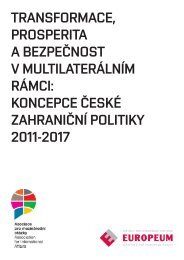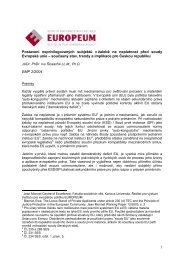eu constitutionalisation - EUROPEUM Institute for European Policy
eu constitutionalisation - EUROPEUM Institute for European Policy
eu constitutionalisation - EUROPEUM Institute for European Policy
Create successful ePaper yourself
Turn your PDF publications into a flip-book with our unique Google optimized e-Paper software.
Chapter 4: Government Coalitions and Institutional Re<strong>for</strong>m at the IGCa working group on institutions – the submission of the Franco-Germancontribution of 15 January 2003’.¹¹⁶ Equality of states and support <strong>for</strong>the Community method, along with the preservation of the institutionalbalance, the guiding principles in the <strong>for</strong>mation of the group, eventuallytranslated into a group proposal ‘Re<strong>for</strong>ming the Institutions: Principles andPremises’ (CONV 646/03), submitted to the plenary by sixteen governmentrepresentatives in the Convention (all of the small states except theBenelux). The paper highlighted the group’s support of the preservationof the rotating presidency; one Commissioner per member state; extensionof QMV; and joining the positions of High Representative and ExternalRelations Commissioner. Denmark and Sweden, traditionally intergovernmentalistcountries, were co-signatories of the paper, however on conditionthat the paper explicitly mentioned that there were two governmentswho were willing ‘to examine the idea of an elected chair of the <strong>European</strong>Council’. The Convention outcome was on many points below the expectationsof the small states. It was clear, there<strong>for</strong>e, that certain issues such asthe composition of the Commission and the system of Council Presidencywould need to be reopened at the IGC.As the IGC progressed, the deal appeared on trading off the small states’concession on accepting the elected President of the Council in exchange<strong>for</strong> the one Commissioner per member state rule. In the meantime, however,the battle regarding the definition of the QMV system was still beingfought, and the small states felt that they had little if any access to theItalian Presidency with their issues. They felt as a group and individuallyas small states largely marginalised.¹¹⁷ After the breakdown of negotiationsin December 2003, the Irish Presidency took over which made a point innegotiating with all. After it became clear that the QMV system wouldchange, the group was eager to negotiate terms favourable to smaller states.They advocated the parity of population and member state thresholds andsmall gap (no less than 10%) between these. Despite the earlier dealingson the question of the composition of the Commission and the system ofPresidency, these remained open basically until the end of negotiations inJune 2004.¹¹⁸ In the final outcome, the decision was made to reduce thesize of the Commission to two thirds of member states, but only as of 2014,116) Birklbauer (2004): 164.117) Ibid.118) Confidential interview with Portuguese and Estonian government official and Italian Presidency officialin Brussels in September 2004.134Chapter 4: Government Coalitions and Institutional Re<strong>for</strong>m at the IGCand this provision could be changed by the Council under unanimity. Inaddition, a declaration was attached guaranteeing that when the size wasreduced, there would be an equal rotation among the member states havinga Commissioner. The ‘Friends’ conceded accepting the new post ofan elected President <strong>for</strong> the <strong>European</strong> Council, however, the President’scompetencies were narrowly limited so as not to overpower the role of theCommission President, whose status was accordingly upgraded.The <strong>for</strong>mation of ‘Friends’ displays strong interest-based motivations as wellas ideological affinities pertinent to the size of population. Power considerationsalso drove the coalition-<strong>for</strong>mation as the small states perceived that inlarge number they were more able to ensure that their interests were notignored by the larger states. The most evident example of this is the fact thatDenmark and Sweden which have more intergovernmentalist preferences,nevertheless decided to be part of the group in defence of the commonsmall states’ interests. The ‘Friends’ could be typologised as a tactical coalitionalthough with more <strong>for</strong>malised cooperation that indicated that someof the members had aspirations <strong>for</strong> building a more strategic coalition.There was no real expectation of future cooperation as a group on otherthan ‘small state’ issues. However, it might have provided a springboard <strong>for</strong>(re)emergence of other sub-groups of ‘Friends’, such as the Visegrad groupor Nordic states or the Central <strong>European</strong> Regional Partnership.CONCLUSIONIn the 2003/04 IGC negotiations, the coalitions of governments can bedivided into two main types: strategic and tactical coalitions. France-Germany and the Benelux displayed all main characteristics of strategiccoalitions: their relationship was long-term, the scope of issues they coveredwas broad and their cooperation was <strong>for</strong>malised regular meetings,joint proposals and public statements. The binding factors in both casesare clearly cultural affinities in combination with geographical proximitywhich have led to building long term relationships and with themmutual understanding and trust. Both coalitions also displayed a highlevel of ambition in influencing the negotiation outcomes, and hencewere motivated to cooperate in view of increasing their relative power.What is particularly important is that the coalitions did not <strong>for</strong>m on thebasis of clearly convergent interests. In fact, in both cases the joint posi-135








